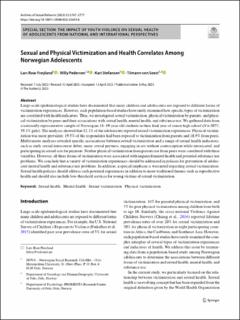| dc.contributor.author | Frøyland, Lars Roar | |
| dc.contributor.author | Pedersen, Willy | |
| dc.contributor.author | Stefansen, Kari | |
| dc.contributor.author | von Soest, Tilmann Martin | |
| dc.date.accessioned | 2024-02-05T10:18:39Z | |
| dc.date.available | 2024-02-05T10:18:39Z | |
| dc.date.created | 2023-05-24T07:00:36Z | |
| dc.date.issued | 2023 | |
| dc.identifier.citation | Archives of Sexual Behavior. 2023, 52 2767-2777. | en_US |
| dc.identifier.issn | 0004-0002 | |
| dc.identifier.uri | https://hdl.handle.net/11250/3115537 | |
| dc.description.abstract | Large-scale epidemiological studies have documented that many children and adolescents are exposed to different forms of victimization experiences. However, such population-based studies have rarely examined how specific types of victimization are correlated with health indicators. Thus, we investigated sexual victimization, physical victimization by parents, and physical victimization by peers and their associations with sexual health, mental health, and substance use. We gathered data from a nationally representative sample of Norwegian 18–19-year-old students in their final year of senior high school (N = 2075; 59.1% girls). The analyses showed that 12.1% of the adolescents reported sexual victimization experiences. Physical victimization was more prevalent: 19.5% of the respondents had been exposed to victimization from parents and 18.9% from peers. Multivariate analyses revealed specific associations between sexual victimization and a range of sexual health indicators, such as early sexual intercourse debut, many sexual partners, engaging in sex without contraception while intoxicated, and participating in sexual acts for payment. Neither physical victimization from parents nor from peers were correlated with these variables. However, all three forms of victimization were associated with impaired mental health and potential substance use problems. We conclude that a variety of victimization experiences should be addressed in policies for prevention of adolescent mental health and substance use problems. In addition, a special emphasis is warranted regarding sexual victimization: Sexual health policies should address such potential experiences in addition to more traditional themes such as reproductive health and should also include low-threshold services for young victims of sexual victimization. | en_US |
| dc.language.iso | eng | en_US |
| dc.rights | Navngivelse 4.0 Internasjonal | * |
| dc.rights.uri | http://creativecommons.org/licenses/by/4.0/deed.no | * |
| dc.title | Sexual and Physical Victimization and Health Correlates Among Norwegian Adolescents | en_US |
| dc.type | Peer reviewed | en_US |
| dc.type | Journal article | en_US |
| dc.description.version | publishedVersion | en_US |
| cristin.ispublished | true | |
| cristin.fulltext | original | |
| cristin.qualitycode | 2 | |
| dc.identifier.doi | 10.1007/s10508-023-02604-8 | |
| dc.identifier.cristin | 2148890 | |
| dc.source.journal | Archives of Sexual Behavior | en_US |
| dc.source.volume | 52 | en_US |
| dc.source.pagenumber | 2767-2777 | en_US |
| dc.relation.project | Norges forskningsråd: 288083 | en_US |

